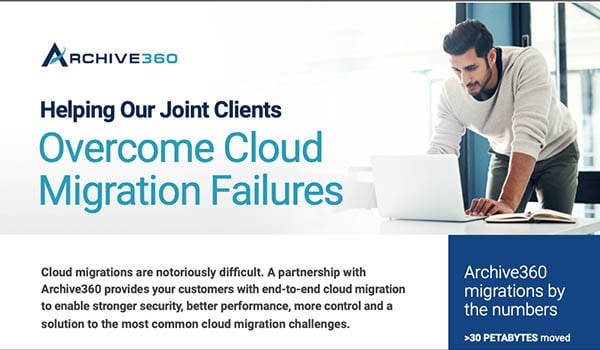Global Relay Alternatives & Migration Software Guide
Thinking about moving to global relay archive or migrating away from it? See how you can unlock the value of your archived data in the secure cloud archive trusted by organizations worldwide.

Table of Contents
If you’re an existing Global Relay Archive user or are planning on moving your legacy on-premises archives to the Global Relay archive, it would be well worth taking a step back and thinking about your options. Global Relay has been a strong business with a competent offering that has served many businesses for years. It was once all you needed to ensure compliance with the financial services data retention and handling requirements mandated by the Securities and Exchange Commission Rules (SEC Rule 17a-4 & Rule 17a-3) and the Financial Industry Regulatory Authority (FINRA).
However, as regulatory requirements and the demands of modern business have changed, aging cloud archives, such as Global Relay Archive, haven’t kept pace with the times. When it comes to moving away from on-premises archives and/or to a more modern cloud archive, there are a number of choices available to you, and it would be wise to evaluate each before making a decision that could be costly to undo.
Migrating Your Legacy Archives to the Cloud
The cloud is a highly appealing option for almost all organizations in the modern business world.
As more ‘born in the cloud’ disruptors enter traditional markets, incumbents must take action in order to ensure they remain competitive, enhancing their operations and unlocking agility and flexibility as well as new ways to do more with their data. Such organizations benefit from powerful tools in the cloud like AI (Artificial Intelligence) and ML (Machine Learning) capabilities, in addition to improved security and scalability.[read more about the use of AI in information management in this blog]

Ultimately, the cloud is no longer a ‘nice to have’ but an essential part of today’s business strategy. You’re likely already thinking about a move to the cloud or even using it in some form within your business. However, to truly unlock the full value of new cloud capabilities, a full migration of your legacy on-premises or first-generation cloud archives is the answer. A migration that is carried out in a fast, legally defensible manner without the risk of data corruption, inadvertent data deletion, end-user productivity issues, or damaging chain of custody, will help to ensure the success of your long-term digital transformation strategy.
The Two Main Migration Options
When it comes to migrating to a new cloud platform, there are two options available to you. One is adopting the seeming simplicity of a SaaS (Software as a Service) archiving solution like Global Relay, Mimecast or Smarsh, that comes at the cost of losing all control over your organization’s sensitive data, including what security protections you deem best, as well as keeping direct control of your company’s encryption keys.
The other option is to migrate your archives to your own public cloud tenant and choose which archiving/information management solution and security capabilities you will rely on.
Option 1: The SaaS Deception
Software-as-a-Service (SaaS) archiving platforms have been around for a long time, and legacy archiving vendors like Global Relay have adopted the SaaS model to deliver their solutions. By allowing a company to avoid significant infrastructure costs, SaaS has, traditionally, been a lower cost, convenient, and hassle-free option and has especially useful for those looking to move away from on-premises archiving. However, SaaS archiving solutions weren’t designed with customization in mind and, in today’s world, their static feature sets haven’t been able to stand up to increasing security needs, the need for flexibility, and unlimited scalability that hyperscale clouds provide. While SaaS solutions might seem like the easiest way to go, they come at the cost of security, access, accountability, and control over your data. In fact, the only comparable benefit between SaaS solutions and public clouds from Amazon, Google, and Microsoft, is the lack of on-premises infrastructure.
While SaaS vendors claim to offer the best turn-key cloud archiving platforms, in reality they suffer from many of the same issues that organizations are looking to move away from, including limited access to the powerful tools, such as Machine Learning, AI, and meaningful analytics available in a true hyperscale cloud. This is largely due to the fact that most SaaS archiving vendors rely on aging designs which make it virtually impossible to upgrade with the emerging capabilities clients are demanding. Additionally, most SaaS vendors don’t own their own datacenters and simply rent parts of a third-party, multi-tenant cloud, further blocking new cloud-dependent technologies from being added.

SaaS architectures also put you, the client, at a major disadvantage – your encryption keys are controlled by the SaaS vendor – which raises major security concerns. This complete lack of control over security and encryption keys means that the keys used to secure your company’s sensitive data could be shared across all of the SaaS vendor’s other clients, producing security weaknesses that could greatly increase your chances of unauthorized access, data corruption, or deletion. This also means that the SaaS vendor can access your company’s sensitive data at any time or provide access to government authorities – without you ever knowing. Further limiting your options, many SaaS vendors store your files in their own proprietary format, meaning your data becomes trapped in what amounts to a data prison where huge “exit” fees can be charged if you ever want to move your data elsewhere. This data ransoming also prevents you from utilizing new powerful data analytics or ML/AI technology to provide content-based auto-classification and supervision for more accurate information management.
With these issues in mind, it’s clear that SaaS solutions create more challenges when it comes to your data. While SaaS platforms offer turn-key simplicity, they also offer minimal advantages over an on-premises solution and severely limit your future options. This begs the question: why not cut out the middleman and retain complete control over your sensitive data in your own cloud?
SaaS Archiving Issues:
- No access to encryption keys
- Little to no control over security policies
- Little or no control over your data’s geographic location – data sovereignty
- Proprietary file formats limit your ability to move your data, without data ransoming
- Limited search and review options for audio, video and other non-email files
- Data analysis and eDiscovery functionality is limited to “lowest common denominator” vendor-provided tools
For cloud archiving solutions that cost as much as SaaS archives like Global Relay do, that’s a lot of issues to contend with.
Believe the SaaS Security Stats
In a recent survey of global IT executives, including VPs, Directors, and members of the C-suite at major corporations, only 19% of those surveyed believed 75% or more of their SaaS vendors met all their security requirements. 70% stated they had been forced to make at least one security exception for a SaaS vendor. While many of these organizations are likely using popular SaaS products like Microsoft Office 365 and Salesforce, where the size and standing of the vendor might make the business more amenable to accepting a perceived lower risk, the clear takeaway is that many SaaS solutions don’t provide the security standards and flexibility modern organizations require.

On the topic of encryption keys, an astounding 95% of respondents believed it was important to control their own encryption keys, and 81% were uncomfortable with their SaaS vendors controlling them. However, 74% of those surveyed said they did not control the encryption keys for the majority of their SaaS solutions. This is a worrying statistic and one that many organizations will have to take steps to reverse as regulations continue to tighten and the threat of cybercrime grows. To that end, 92% of executives said they would require more security customization in the future, with 63% of them planning to retire current SaaS applications that don’t provide them control over encryption key creation and management.
These statistics paint a clear picture of the security landscape and the risk that the one-size-fits-all approach of SaaS vendors introduces. As the trend for security customization continues and scrutiny over data access and handling increases, SaaS solutions will become increasingly less palatable for organizations’ risk mitigation efforts. Instead, more secure and customizable solutions will be a major focus.
Soft SaaS security: Providers like Global Relay don’t allow you control over…
- Threat detection
- Identity management
- Application security analysis
- Firewall and firewall rules
- Cloud-native directories
- Custom compliance reporting
- Encryption keys
- Physical data center security
Moving to the hyperscale cloud will also mean changes to your security capabilities over what you have been used to in a static SaaS cloud. Remember, the SaaS platform was a “one size fits all” solution so took care of everything for you. But, with a hyper-scale cloud, you are able to customize your security environment to what best fits your company’s needs. Hyperscale clouds don’t restrict you when it comes to your own security policies, enabling you to follow the same processes and comply with the same regulations as you did on-premises, not to mention the fact that hyperscale cloud providers are the best in the business at keeping data safe. The major players, like Microsoft and Amazon, can’t afford to be lax when it comes to system protection. Not only does their size and ubiquity make them targets, but they know that a significant breach could mean irreparable damage to their respective businesses. It’s for this reason they dedicate hundreds of millions of dollars and countless experts to platform security every year in order to stay ahead of the threats and be as prepared as possible when it comes to emerging risks. SaaS vendors can’t match this level of investment or dedication to security. They don’t have the funds or resources and, ultimately, can’t afford to make security their primary focus.
Option 2: A Cloud you Control
The only way to ensure you retain complete control over your sensitive archived data and can apply your own security standards and protocols is to migrate your legacy archive data to an archive hosted and managed in your own secure hyperscale cloud.
Microsoft and Amazon are the frontrunners in this hyper-scale cloud space and, with the right information management and archiving solution, can provide you with complete control over your data. In your own hyperscale cloud tenant, you can store files in their native format and enjoy best-in-class security and management features as standard. You can also make use of cloud-scale AI and Machine Learning to unlock crucial business insight from your data, as well as automate data management and handling for accurate supervision, predictive surveillance, auto-classification, and eDiscovery response. These crucial, future-proof features simply aren’t possible with a SaaS archive and highlight the limitations of their compromised, aging cloud platforms.
Your own public cloud should provide you with...
- Immediate access to your data in its native format
- Full control of where data is stored for data sovereignty
- Complete, customizable control over security, compliance, and privacy
- Flexibility and on-demand scalability – use only what you need
- Reduced upfront investment and predictable ongoing costs – CapEx versus OpEx
- The ability to move your data out of the archive without ransom fees
- Faster, scalable eDiscovery searches and case management, as well as customizable retention/disposition policy controls for regulatory compliance
- Access to the latest AI and ML technology for auto-data classification, data mining, and analysis
- The ability to granularly search and review content within audio, video and social media files
Archive360 Open Archive vs SaaS Archives
| Features | SaaS Archives | Open Archive |
| Infrastructure | ||
| Host data in your corporate cloud | ||
| Security | ||
| Protect Data with encryption keys | ||
| Compliance | ||
| Meet SEC 17a-4 regulations | ||
| Meet GDPR Regulations | Limited | |
| Policy-driven records | Limited | |
| Compliant onboarding | ||
| Performance | ||
| Active user-based pricing | ||
| Management | ||
| Standard eDiscovery with case management | ||
| AI-powered eDiscovery | ||
| Manage any content/data type | Limited | |
| Records analysis, classification and management | Limited | |
| Policy-driven records classification and transformation | ||
| Data Loss Prevention and sensitive data analysis alerts | ||
| Export and produce data for third party consumption | ||
| Role-based access with Active Directory Integration | Limited | |
| Native import and export with O365, SharePoint Online and OneDrive | Limited | |
| Onboarding | ||
| Accelerated onboarding at 50 TB per day | ||
| Restore legacy archives back to native format | ||
| Pricing | ||
| Active user-based pricing | ||
| Interactive Users - free of charge (restrictions apply) |
Migrating Your Data Out of the Global Relay Cloud
 Making the decision to move to a new cloud platform is one thing, but what about the terabytes or even petabytes of data stored in your legacy Global Relay Archive? To access the features of the hyperscale cloud, you first need to find a partner to move your data quickly, seamlessly, and painlessly to the cloud without the risk of leaving data behind, losing data in route, or interrupting the day-to-day operations of your business. A number of companies provide migration solutions, including QuadroTech and Transvault; however, we believe that the key is a high performance email migration tool that can not only move your data to the new cloud at the highest possible speed but ensure the migration is complete, accurate, and is legally defensible, including protecting the chain of custody. In addition to choosing a migration partner, you will also need to make additional key decisions at this stage. They include whether you want to archive or journal in the new cloud, and whether you intend to move your existing archived data to Office 365, another email archive, or your company’s own hyper-scale cloud tenancy.
Making the decision to move to a new cloud platform is one thing, but what about the terabytes or even petabytes of data stored in your legacy Global Relay Archive? To access the features of the hyperscale cloud, you first need to find a partner to move your data quickly, seamlessly, and painlessly to the cloud without the risk of leaving data behind, losing data in route, or interrupting the day-to-day operations of your business. A number of companies provide migration solutions, including QuadroTech and Transvault; however, we believe that the key is a high performance email migration tool that can not only move your data to the new cloud at the highest possible speed but ensure the migration is complete, accurate, and is legally defensible, including protecting the chain of custody. In addition to choosing a migration partner, you will also need to make additional key decisions at this stage. They include whether you want to archive or journal in the new cloud, and whether you intend to move your existing archived data to Office 365, another email archive, or your company’s own hyper-scale cloud tenancy.
Archive Migration
Our combination of experience and cloud-based automation is going to make you look really good.
- Complete chain-of-custody and exception reporting down to the item level
- Advanced features for managing your stubs to ensure your end-users experience zero disruption
- Unique approach to handling journal archives your legal and compliance teams will appreciate
- Many destination options including Office 365 and dozens of other cloud-based and on-premises archives
Open Archiving
We interviewed 1,100 customers to learn what they loved and hated about their legacy archive and used that insight to create a completely new kind of archive platform.
- More secure: If you don't control your encryption keys, you don't control your data. With our archive, only you have access to your encryption keys.
- More private: Privacy laws require you to retain data in the region it was created. SaaS archives don't do that. Our archive automatically stores employee and customer data in the country of origin.
- More insight: Your archive holds incredible insight that until now has been trapped in a black box. Our archive empowers you to extract intelligence from your emails, files and videos for the first time.
Your Global Relay Migration Questions Answered
Archive360 understands the significance of an organization’s move to a hyper-scale cloud and the concerns that go with such a decision. With more than a thousand legacy archive migrations completed successfully, we know the types of questions you need answers to and can help dispel any fears you might have in our initial discussions. The questions we hear most often include…
- How much data do I actually have in my archive and what kind of data is it?
- Is there a cost to move my data out of the Global Relay archive? If so, what is the cost?
- Does the archived data need to be reconverted back to its original format?
- How much “dark data” do I have (such as archived messages from inactive users and leavers)?
- Do I need to migrate the entire archive and/or the journal archive?
- I have ongoing or pending litigation; can I still migrate my archived mail?
- How do I manage archived email that is under legal hold? What special handling is needed to maintain chain of custody?
- Will I be able to account for 100% of my archived mail?
- How long will the migration take?

Learn More
Archive360 Email Migration Software Product Highlights
Archive360 offers the most trusted email archive migration solution available - specifically designed for the Global Relay archive. Archive360 extracts messages and attachments, including all metadata, directly from the archive, and maintains an item-level audit trail for compliance and legal reporting. It also preserves complete, original message fidelity for eDiscovery and regulatory information requests.
Archive360’s Global Relay Migration Details
- Utilizes a multi-threaded, multi-server architecture
Provides the highest performance and accuracy of all migration solutions - Does not require indexing or data gathering before extraction
Begin message extraction within minutes of installation unlike other solutions that take days or weeks to index before project start - Message level chain of custody reporting
Legally defensible reporting reduces eDiscovery risk - Intuitive and powerful graphical user interface
Less time needed for training – faster time to migration
The Cloud Archive Organizations Trust
Archive360 provides the cloud archive trusted by enterprises and government agencies worldwide, purpose-built to run in the hyperscale cloud. Installed and run from your organization’s individual public cloud, you retain all the power, flexibility, and management while maintaining complete control of your data and its security, including encryption keys that only you have access to. Additionally, unlike on-premises and SaaS archiving solutions, you are free to unlock valuable insights via data analytics and carry out powerful searches on your data using the latest cloud-based tools that will benefit multiple teams across your business, from HR to legal and compliance.
Archive Migration Connectors
Archive360 has successfully helped more than 2,000 customers extract data from 20+ enterprise archives, legacy applications, and file system repositories, including the following:
(click on the link for more information)
- ArchiveOne C2C
- Autonomy EAS
- Autonomy NearPoint
- Autonomy Consolidated Archive
- EMC EmailXtender
- EMC SourceOne
- Gwava Retain
- Dell EMS MessageOne
- Dell Quest Archive Manager
- HPCA
- Opentext AXS-One
(Exchange and IBM Notes) - Opentext Email Archive
(Exchange and IBM Notes) - Opentext IXOS
(Exchange and IBM Notes) - Commvault Simpana
- Zovy Archive
- Metalogix
- PSTs
- IBM NSFs


